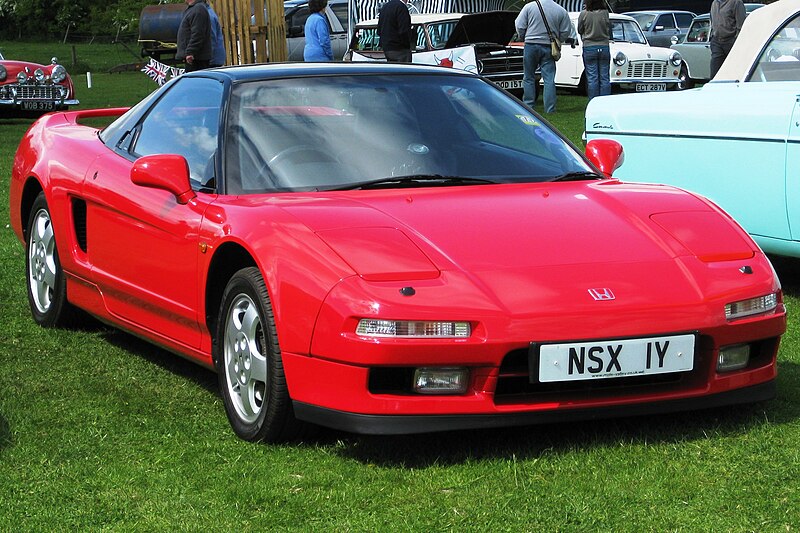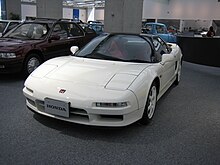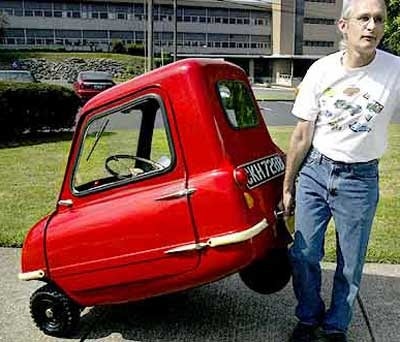 |
| Source: https://en.wikipedia.org/wiki/Fiat_124_Spider_(2016)
Ah, the revival of a classic moniker, that captivates car enthusiasts from 1966-85. The Fiat 124 Sport Spider was a roadster that appealed to the enthusiasts looking for a basic top-down sports car during that juncture. Fast forward to 2016, Fiat Chrysler Automobile (FCA) has brought back the 124 nameplate, christened as the 124 Spider.
Unlike the Pininfarina-designed 124 Sport Spider, the modern 124 Spider is not a result of Fiat and Pininfarina's collaboration, but rather a joint venture with a Hiroshima-based manufacturer who subscribes to the Jinba Ittai philosophy in sports car design. If you can guess what I am alluding to, kudos to you. But in case if you don't, the manufacturer in reference is Mazda.
The 124 Spider is underpinned by the fourth generation ND Mazda MX-5 (MX-5 Miata in the US). Thanks to findings by Top Gear, the chassis is built in Mazda's Hiroshima factory. The engine, however, is not built by Mazda, but by Fiat instead. In a nutshell, lurking under the 124's bonnet is Fiat's proprietary 1.4 liter turbocharged MultiAir four banger rather than Mazda's 2.0 litre Skyactiv-G naturally aspirated four banger. Result? The 124 Spider makes more power than the MX-5, 160 for the 124 Spider vs 155 for the MX-5. Does not sound much, but every ponies count. Upon completion, the engine is then shipped to Hiroshima where Mazda's engineers marry the engine to the chassis.
Fiat engineers then applied their own Jinba Ittai to the suspension tuning, with retuned dampers, stiffer springs and anti-roll bar to embarrass the donor car in the twisty bit.
Taking advantage of the extra low-end torque, Fiat lengthen the gear ratio. The extra grunt at low rev is more than enough to compensate for the longer gearing.
All these retuning sounds like a recipe for a more unadulterated driving experience. With more power and an uprated suspension, this little pocket rocket may have what it takes to make MX-5 owners clamouring for the 124 Spider.
Source: Top Gear |
A laundry list of car reviews, opinion pieces, technical articles and curated articles just for you!
14 Jun 2016
Fiat 124 Spider, an ND MX 5-bodied Italian sports car
Brake Override System
| Source: http://www.nissanusa.com/blog/brake-override-system |
Brake Override System is a safety feature that allows the ability to stop a car even with the accelerator pedal depressed at the same time with the brake application.
Why such feature is introduced on modern cars? One notable example that became fodder to the system's introduction is the fatal crash involving Mark Saylor, a California Highway Patrol officer, and his family, when the accelerator pedal of their Lexus sedan became stuck, leading to a deadly runaway car. Investigators blamed the accident on ill-designed floor mat that obstruct the accelerator's movement, meaning the risk of the accelerator not fully releasing is hazardously high. In light of the accident, National Highway Traffic Safety Administration (NHTSA), an executive branch of the US government under the Department of Transportation, has mandated the system to be implemented by every manufacturers in a bid to protect vehicle occupants in an event of stuck accelerator pedal.
Why such feature is introduced on modern cars? One notable example that became fodder to the system's introduction is the fatal crash involving Mark Saylor, a California Highway Patrol officer, and his family, when the accelerator pedal of their Lexus sedan became stuck, leading to a deadly runaway car. Investigators blamed the accident on ill-designed floor mat that obstruct the accelerator's movement, meaning the risk of the accelerator not fully releasing is hazardously high. In light of the accident, National Highway Traffic Safety Administration (NHTSA), an executive branch of the US government under the Department of Transportation, has mandated the system to be implemented by every manufacturers in a bid to protect vehicle occupants in an event of stuck accelerator pedal.
| Source: http://brainonboard.ca/safety_features/active_safety_features_brake_override.php
How does it work? When the system detects that both pedals are depressed at the same time, it gives the brake more precedence. In a nutshell,even with the accelerator depressed, the system will make it feel like the accelerator is fully released, enabling your brake to slow the car down effectively. This should in theory prevents you from roaring down the highway with a death note sticking on your forehead.
Should this system be featured on every new cars? Like every safety features, one must know how to use it and remain responsible on the road. It is not a great idea to fall into a false sense of security thinking you can drive around like you are in Too Fast Too Furious movie scene. Nevertheless, any features with life-saving potential make great sense as an extra protection to keep you out from a wreck. |
11 May 2016
Peel P50
5 May 2016
Honda NSX
 |
| Source: https://commons.wikimedia.org/wiki/File:Honda_NSX_reg_1991_2977_cc.JPG |
What do you get if you take a Honda with Pininfarina-designed body panel and inject sporty DNA into it's vein to challenge the likes of Ferrari? The answer is the Honda NSX. Though it went into production in 1990, it's development began in 1984.
Tracing it's root back to 1984, Honda approached Pininfarina, an Italian coachbuilder, to commission the HP-X (Honda Pininfarina eXperimental) concept with a 2 litre V6 engine mounted amidship.
| Source: http://www.topspeed.com/cars/honda/1990-2005-honda-nsx-ar1449.html |
During it's development period, the Honda management figured they could create a supercar that rivals the performance of the Ferrari while offering stellar reliability and lower price tag. As a result, the HP-X concept evolved into the NSX (New Sportscar eXperimental).
Honda set the Ferrari 348 as a benchmark. To fulfill Honda's vision to put the 348 to shame, out goes the 2 litre V6 from the concept and in goes a more powerful mid-mounted transverse 3 litre VTEC DOHC V6 with a variable length intake manifold that churned out 270 bhp to the rear wheels via a 5 speed manual. The use of titanium connecting rod further optimised the output of the 'Ferrari burner'.
In the chassis department, the Honda engineers received a helping hand from the late triple F1 champion, Ayrton Senna who clinched the 1988, 1990 and 1991 title driving for the McLaren Honda team. Thanks to his input, the NSX chassis gained the much needed rigidity, and much beefier double wishbone suspension all-round, endowing Honda's answer to Ferrari with an impressive cornering speed.
Weight reduction played a crucial role to the NSX's quest to demonstrate its performance credibility. This called for aluminium body panel and aluminium suspension arms. The extensive use of aluminium endowed the NSX with a curb weight of 1370 kg.
 |
| Source: https://en.wikipedia.org/wiki/Honda_NSX_(first_generation)#1992_NSX-R_.28Japanese_domestic_market.29 |
Throughout it's production run from 1990-2005, the NSX had gone through several upgrades. Most notably was when the first iteration of the NSX-Type R, or NSX-R, was rolled out the assembly line in 1992 featuring a much larger, more powerful 3.2 litre V6 tuned by Mugen, extensive weight reduction, extra beefy suspension and a more aggressive final drive ratio up to 4.235:1 from the stock 4.06:1 for eyeball-popping acceleration. In 2002, the NSX Type R received a facelift which saw the introduction of carbon fibre to further cut weight and boosting power via engine tweaking. The result is a Nurburgring lap time of 7:56 rivalling the Ferrari F360 Challenge Stradale, set by a former Japanese racing driver and current Best Motoring presenter, Motoharu Kurosawa.
To this writer, the NSX is Honda's stepping stone to challenge the European performance icon. The recently launched second generation NSX with it's new powertrain represents the stride Honda has made to become a major player in the high performance car industry.
Bravo Aston!
 |
| Source: www.dubicars.com |
Okay, what is so special about Aston's new V12 Vantage S compared to the previous iteration? Well, it is not really Aston going bonkers with liberating extra juice from the same 6 litre V12 (it still makes the same 563 hp at 6750 rpm and 620 Nm of torque at 5750 rpm). What makes it special is the bit that passes the V12 power to the rear wheels, the transmission.
What is so special about the transmission I heard you ask? Well, the new V12 Vantage S is a departure from the previous model where manual was not even an option (only a 7 speed Sportshift III automated manual was offerred mind you). This time round our Gaydon friend has shoehorned...hold your breath...3 pedals and a human-operated H-gate shifter!
| Source: paultan.org |
To top it off, the transmission is equipped with the AMSHIFT, which automatically blips the throttle on downshift to simulate a clean heel toe downshift, made possible by clutch, gear position and propshaft sensor. If you wish to do your own heel toe, the system can be turned off.
The return of manual in the V12 Vantage S after a brief hibernation should be a welcome relief to the enthusiasts camp. The 7 speed Sportshift III automated manual remains an option in the new Vantage S if clutching in and out is not your idea of driving.
4 Mar 2016
Self-shifter 'GT3 RS', Porsche's commitment to the 3 pedal 911?
Source: porsche.com/italy/models/911/911-r/
All hail the brand new Porsche 911 GT3 RS with it's appetising, raucous 4 litre naturally aspirated flat-six, giant rear wing and....hang on a minute? Is that a PDK gear selector sticking out from the centre console? Heads bow in abject dejection. Stirring the H-gate stick is not even an option on the GT3 RS because being a track car, beating the clock is of much greater importance than indulging oneself in a self-gratifying heel toe downshift. |
| Source: porsche.com/italy/models/911/911-r/ |
With the same 4 litre naturally aspirated flat-six derived from the track-going GT3 RS slung out at the back, your insatiable desire for tactile pleasure of feeling the cogs stirring under your palm, the 911 R will surely stroke your insistence for 'manualness' (do the word even exist?).
| Source: porsche.com/italy/models/911/911-r/ |
"It's a unique selling proposition for Porsche to have a manual in the 911 range, and I think we will fight for that as long as possible," he told Car And Driver. "Even if it's only 10 percent of the market, it's important for some customers and for some markets, especially the U.S., to have that kind of gearbox."
He also acknowledges the emotional appeal of flicking the gear lever.
"What we learned from the last two years with the Cayman GT4 and Boxster Spyder is that it's not only a discussion of lap times, but also of emotion, of being fun to drive," he said. "Even if the car is not the fastest, it is fun to drive with a manual. Of course the PDK is faster, but a lot of customers want to change gear by themselves. Therefore I think we should keep it, for the next generation also."
The 911 R is a sign of Porsche's dedication to keep manual in the 911 family as long as a sizeable number of customers ask for it.
Features treating future 911 R owners are automatic rev matching function which can be switched off by a press of a button and an optional single mass flywheel for extra zing when you gun the loud pedal.
Rear wheel steering and mechanical rear locking differential will ensure enhanced stability while you are busy heel toeing to gratification.
To keep 500 hp in check, Porsche Ceramic Composite Brake is standard for an eye-popping stopping power. With lap time not prioritised, the rear wing had been hacked off.
Features treating future 911 R owners are automatic rev matching function which can be switched off by a press of a button and an optional single mass flywheel for extra zing when you gun the loud pedal.
Rear wheel steering and mechanical rear locking differential will ensure enhanced stability while you are busy heel toeing to gratification.
To keep 500 hp in check, Porsche Ceramic Composite Brake is standard for an eye-popping stopping power. With lap time not prioritised, the rear wing had been hacked off.
Unlike certain automakers who had completely threw manual into the dumpster (Ferrari and Lamborghini comes to mind), Porsche has not completely given up on the row-your-own-gear option. The 911 R may well be a ray of hope for the manualphiles around the globe that the surge of the state-of-the-art, lap time 'special' automated transmission will not completely supplant the traditional tactility that 3 pedals and H-gate shifter provide to those who do not see clutching in and out as a humdrum chore.
9 Feb 2016
BMW M hybrid in the offing? Will Munich implement hybrid in spite of weight handicap?
 |
| Source: qJake via Flickr CC BY-SA 2.0 |
Thanks to the likes of McLaren P1, Ferrari LaFerrari and Porsche 918 Spyder, performance sectors are giving hybrid their graceful touch. Formula E , Porsche Mission E concept and Mercedes AMG SLS Electric Drive give performance cars some nice zap of electric shock. Hybrid and electric powertrain are not only constrained in your run-of-the-mill family cruiser, but also in muscle-bound brute that spells P.E.R.F.O.R.M.A.N.C.E.
In an interview conducted by Auto Express, Dirk Hacker, vice president in the M division, admitted that hybridisation and electrification may be the future of M cars.
"We will look at electrification-I think it could be inevitable-but it depends on the possibility of increasing performance," Hacker said. He immediately noted that hybrid M will not be implemented right off the bat due to weight concern and will only consider hybrid if it offers performance improvement.
When asked on the possibility of electric M cars, Hacker dismissed the latter due to customer demand.
"We've found that our customers are not interested in driving without the combustion engine," Hacker said. "They want to know if these changes will help with performance." Seems like electric M is out of the question. Phew. This writer cannot imagine standing next to an eeriely quiet M car.
If that is the case, looks like our friend at BMW M is looking to hybridise their performance segment not in the name of efficiency but performance. The VP's concern on the weight of hybrid powertrain reminds this writer on Koenigsegg's chief concern during the development of their hallow Regera hybrid: weight.
Not surprisingly, weight is a performance killer. Shedding weight is a goal of every performance cars. Take for instance the likes of Ariel Atom 3.5R and Ferrari 458. The latter is more powerful than the former. However, the Atom sprints from 0-62 mph in just 2.6 seconds to the 458's 2.9 seconds. Wait a minute, how can the Atom with 350 hp 2 litre supercharged Honda 4 cylinders outgunned the 458 with its more powerful 562 hp 4.5 litre V8? The Atom only weighs 550 kg to the 458's 1485 kg. This emphasises in the performance realm, taking into account only power output is not enough. Power-to-weight ratio is the holy grail in making a car a speed demon. The VP's concern on hybrid drivetrain's weight may allude to boosting power-to-weight ratio.
This writer wonders if hybrid M do come into production, will the engineers at M division ponder on imitating Koenigsegg's trick in overcoming the weight handicap of their Regera hybrid: dispensing the transmission altogether. Will this be the recipe for crazy power-to-weight ratio?
Subscribe to:
Posts
(
Atom
)

